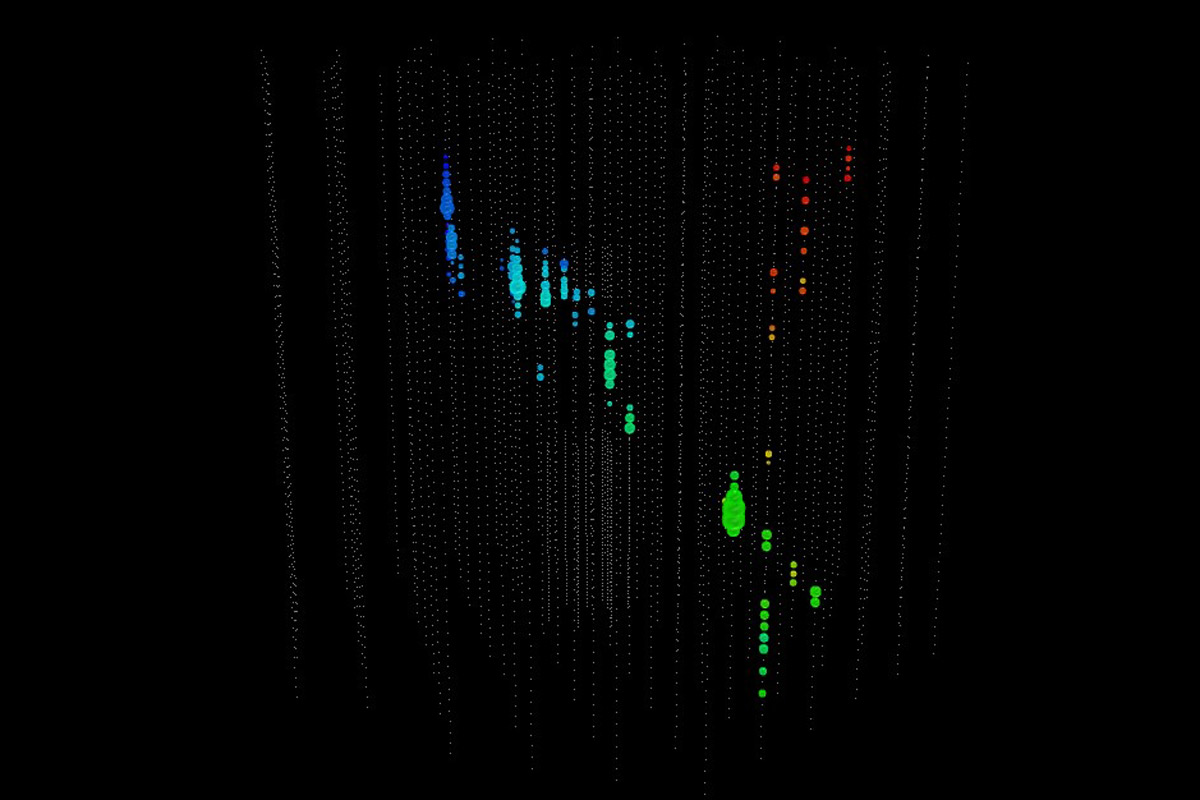Section 3 –
Realizing the Research Plan
Bringing the ambitious plans of the Canadian subatomic physics community to fruition will require support from multiple sources: the major onshore research facilities, TRIUMF, SNOLAB, and the Perimeter Institute; the universities that support the majority of subatomic physics researchers including students and postdocs; supporting infrastructure such as high-performance computing and networking; and the federal funding agencies NSERC and CFI. In addition, the community will need to be cohesive and inclusive to efficiently tackle the science drivers and optimize trainee success.
Canadian Subatomic Physics Community
The pursuit of the research plan depends first and foremost on the Canadian community of subatomic physics researchers. This community has been successful on the global stage through its organization and a cohesive collaborative approach. It is also truly national, with Figure 5 and Table 1 showing the geographical distribution of grant-eligible investigators in subatomic physics and its evolution over a time scale of 10 years. The subatomic physics community continues to be vibrant with strength across all regions in Canada, with significant recent growth in Ontario. The renewal of senior investigators in the community, at just over 2% per year, is consistent with the expected retirement rate, but there has recently been additional growth driven in part by the injection of CFREF funding through the McDonald Institute and the consequent hiring of 12 new faculty. Further renewal over the coming decade will be needed. In this regard, the TRIUMF faculty bridge program is effective and such links between universities and national Canadian facilities could be expanded to further support community renewal.
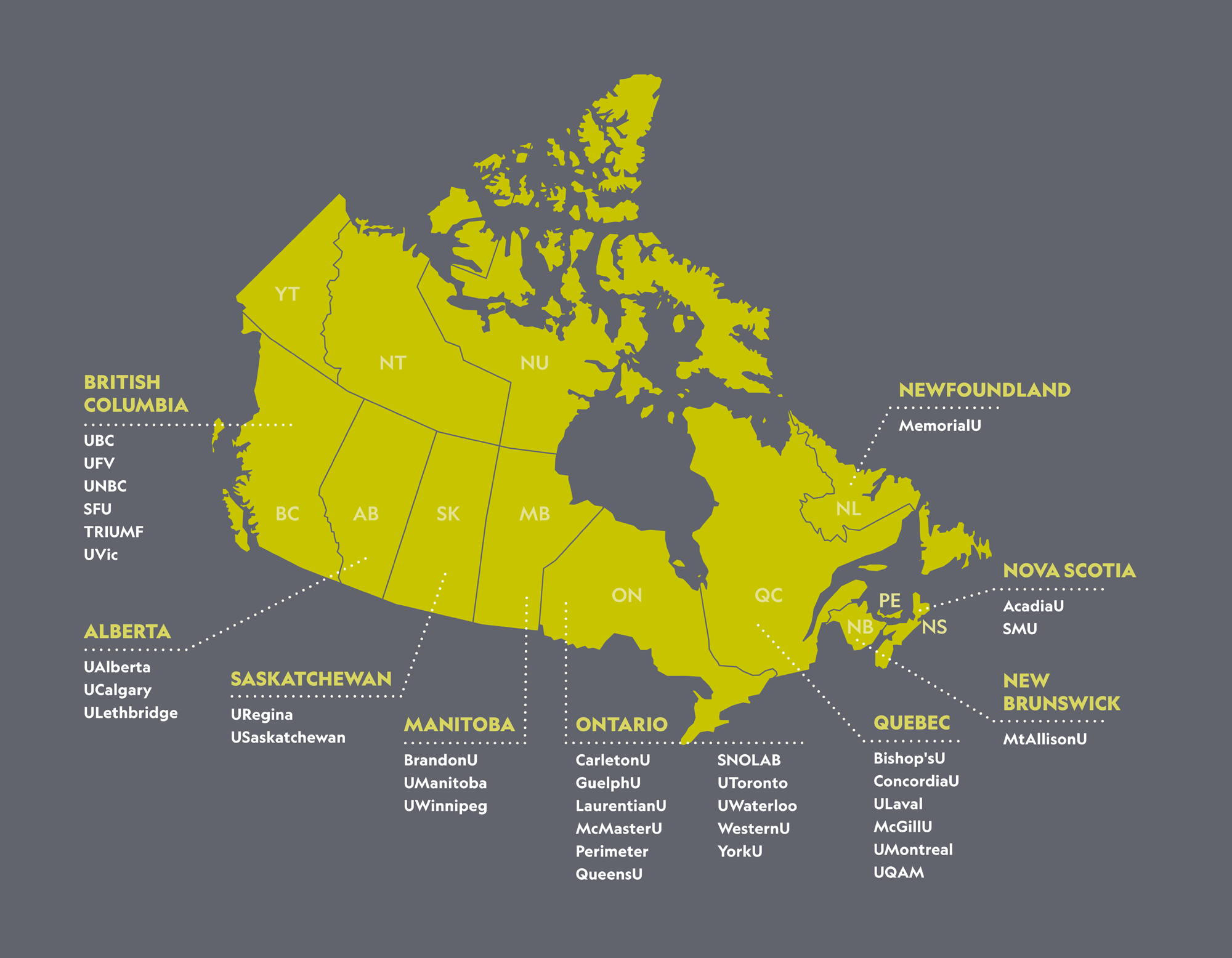
| Region | 2011 | 2015 | 2021 |
|---|---|---|---|
| British Columbia (BC) | 86 | 88 | 88 |
| Prairies (AB, SK, NB) | 38 | 38 | 40 |
| Ontario (ON) | 60 | 66 | 81 |
| Quebec (QC) | 35 | 31 | 32 |
| Atlantic (NL, NB, NS, PE) | 6 | 8 | 8 |
| Total | 225 | 231 | 251 |
The research profile of the Canadian community has evolved over the past two decades, to reflect progress in the field and evolving science priorities. Figure 6 shows the changing research trends within the community over the past 20 years, for example the increased focus on neutrino properties and searches for dark matter, consistent with global trends and the presence of SNOLAB in Canada. Looking forward, given Canada’s primary position hosting TRIUMF and the start of operation of several new international facilities over the next decade (e.g. FRIB and FAIR), there are opportunities for growth in the area of nuclear structure.
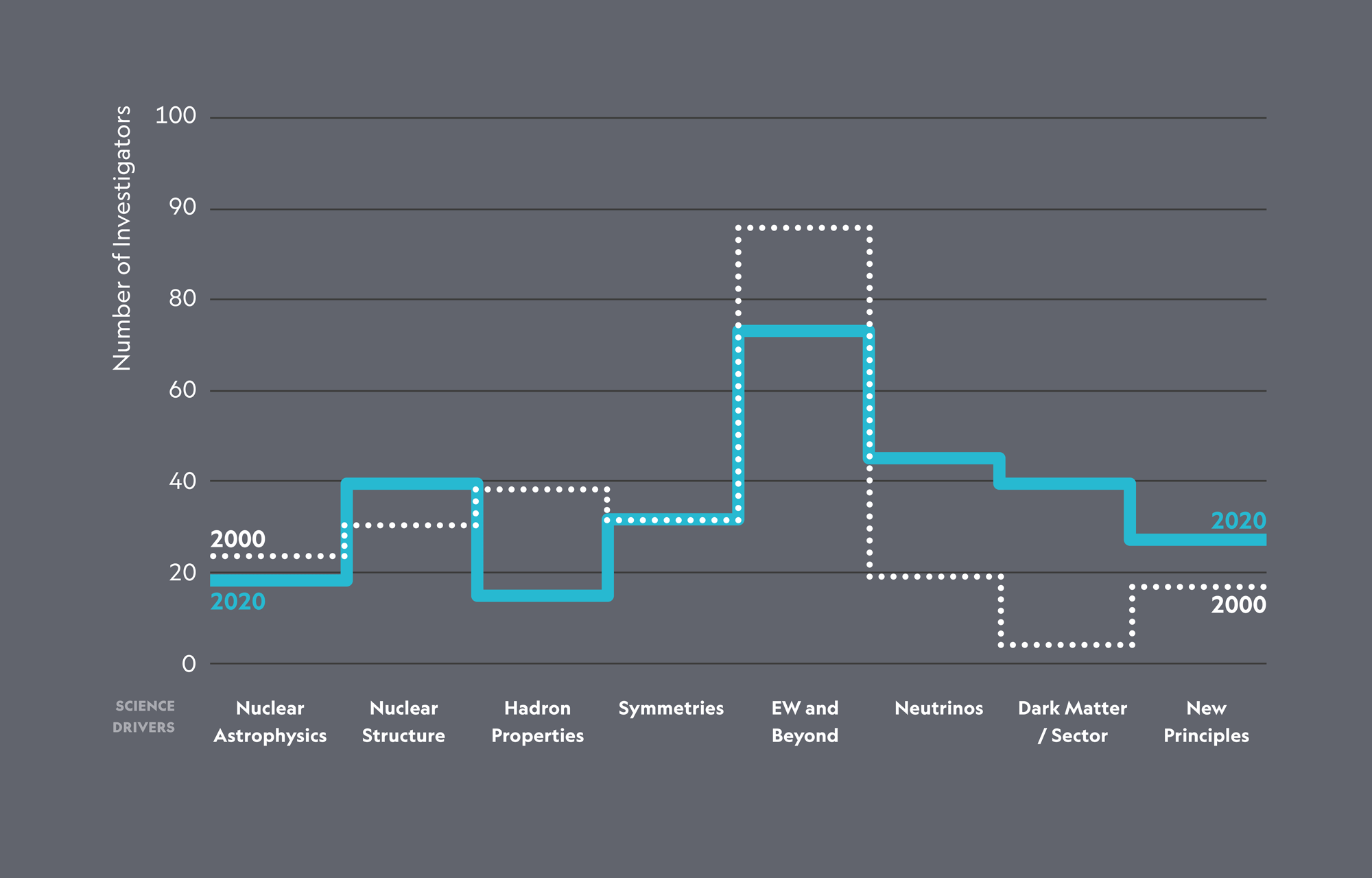
| Year | Grad Students Supervised (Average per FTE) | Grad Student Capacity (Average per FTE) |
|---|---|---|
| 2015 | 2.1 | 3.7 |
| 2020 | 2.6 | 3.7 |
Subatomic physics is a research field that relies critically on the interplay between theory and experiment for progress. The Canadian theory community has traditionally comprised roughly 30% of the community as a whole, but the number of NSERC-funded theory investigators has dropped slightly over the past decade to 24%, although the total number of investigators has grown. There is strong support within the broader subatomic physics community for a vibrant theory program, and Canadian theorists have had success and global impact across multiple sub-fields; we therefore see the opportunity for growth in the Canadian theoretical effort. In this regard, it is also vital that the two primary themes of theoretical research — formal development of new principles and structures, and synergistic phenomenology with experiment — be vigorously pursued. All aspects of theoretical research benefit from effective channels for communication and collaboration. Building on the work of existing centres such as the Perimeter Institute, the McDonald Institute, Banff International Research Station (BIRS), TRIUMF and SNOLAB, there are opportunities to further support the theory community with thematic workshop programs that have been successful elsewhere around the world, e.g. at institutions like the Kavli Institute for Theoretical Physics (KITP) and the Institute for Nuclear Theory (INT) in the US, CERN in Switzerland, Mainz Institute for Theoretical Physics (MITP) in Germany, and the European Centre for Theoretical Studies (ECT*) in Italy.
The subatomic physics community is also developing cross-disciplinary collaborations with adjacent research fields, as highlighted in Section 1. This is highly valuable, as such collaborations have traditionally provided fertile ground for both new theoretical ideas and new technological applications. There are important overlaps in science goals with areas of astronomy and cosmology; atomic, molecular, and optical physics; and materials science more generally. Cross-disciplinary collaborations are also driven by overlapping technological tools, and by the development of emerging technologies such as quantum sensing.
Beyond the scientific profile of the subatomic physics community, there is also a need to address broader issues of equity, diversity and inclusion. Canadian society is diverse, and the celebration of this diversity is an important aspect of our national identity. Moreover, equality of opportunity and equitable representation are important drivers for the economy and for scientific progress. A national physics-wide community survey by the CAP EDI committee in 2020, confirmed that diversity within the field does not match the broader society. Indeed, the fraction of NSERC grant holders in the subatomic physics community who are women has evolved from 12% in 2016 to 15% in 2021, but remains well below the level in a number of other STEM fields. The CAP EDI survey indicated that within the wider physics community, these gender disparities are similar at all levels from undergraduate students to faculty, while the disparities for other equity groups were more significant for those in later career stages. While the final results of the survey were not available at the time of writing, the LRP Committee partnered with the CAP EDI survey team to add questions that would allow responses from the subatomic physics community to be separated from those of the broader physics community. Thus, while the initial survey in 2020 provides a baseline, in coming years the longitudinal data from annual surveys will provide valuable input for the community to assess progress toward diversity goals, and the inclusivity of the community overall. In this regard, the efforts led by funding agencies such as NSERC and CFI to ensure that review committees are diverse, and requiring grant applicants to address EDI initiatives explicitly is welcome.
Community Recommendation
5 —
Equity, Diversity & Inclusion
The Canadian subatomic physics community lacks diversity, as do some other science and technology fields. This lack of representation has many causes, and spans the full career range from graduate students to senior faculty. It is widely recognized that diversity is valuable for the research enterprise, and that a lack of diversity in itself creates a barrier to entry into the field.
- We recommend the pursuit of further sustained actions aligned with the Tri-Council Dimensions Charter, including regular data-gathering and analysis, targeted initiatives to enhance equity, diversity and inclusion within community activities, and community use of formal committees through the Institutes to support these efforts and/or coordinate with partners.
- We recommend that the subatomic physics community promote balanced representation in high visibility leadership roles, as individuals in these positions are important role models, while recognizing that achieving adequate representation can increase the workload for members from under-represented groups.
- We recommend that the subatomic physics community promotes inclusion through acknowledgement of the legacy of colonization in Canada, e.g. with the use of land acknowledgements at events held in Canada, consistent with the spirit of the Calls to Action of the Truth and Reconciliation Commission of Canada and of the United Nations Declaration on the Rights of Indigenous Peoples.
I learned a lot beyond the scope of research by having a female advisor. I saw a glimpse into the extra work that minority faculty members face in universities. My particular advisor was involved in Equity, Diversity, and Inclusion (EDI) and outreach programs. One of these programs focuses on bringing indigenous high school students to the University of Manitoba to experience different science programs with the hope of encouraging those individuals to pursue scientific studies. Participating in these outreach programs gave a better understanding of what other people experience within Canada.
— Brynne Blaikie (MSc, University of Manitoba, 2022)
The Canadian subatomic physics community includes many undergraduate and graduate students, postdoctoral fellows and research associates, who provide the engine that drives significant research progress and who receive broad training in a technical and international research field. This training is an integral component of the subatomic physics research program. As discussed in more detail in Section 4, one special feature of training within subatomic physics is the highly collaborative and international nature of its activities. The LRP community survey highlighted a significant latent capacity for additional graduate student training (see Table 2). This capacity represents a valuable opportunity to maximize both the scientific output from existing investment, and the training of highly-skilled members of the Canadian workforce.
Career development for new faculty and research scientists within Canada is also critical for renewal of the research field. Another outcome of the community survey was that Early Career Researchers (along with all faculty and researchers to a lesser extent) highlighted the ability to recruit talented trainees as the primary barrier to increased research productivity. There are opportunities for the collaborative nature of the field to again provide support, through efficiently sharing of information. It is also recognized that supplemental research funding and time for research can be highly valuable during the early years of a career. The newly rebranded NSERC Arthur B McDonald Early Career Research Fellowship program provides such support; an expansion to match the scale of similar early-career programs in other countries would be valuable within subatomic physics and in other Canadian research fields to kickstart the careers of new faculty and research scientists.
Community Recommendation
6 —
Training & career development
To enable highly qualified personnel to receive training that makes use of the national collaborative structure of subatomic physics research, we recommend the coordination and sharing of training opportunities across Canadian centres, institutes, and universities.
To support early career development, we recommend that Early Career Researchers be supported to quickly gain knowledge of the Canadian subatomic physics research support and funding ecosystem, and be given opportunities to interact broadly with the community.
The Canadian subatomic physics community has used self-organization effectively to increase its global impact, and supported the community Institutes which can provide advocacy to government and funding agencies. The LRP processes operating every 5 years are an important part of community organization, but the LRP Committee also sees value in formalizing some existing and successful, but less formal, advocacy activities carried out on a more frequent basis, for example by the community Institutes CINP and IPP.
Community Recommendation
7 —
Communication & Engagement with Agencies & Government
We recommend the formalization (e.g. by CINP and IPP) of a subatomic physics consultation committee for engagement and advocacy to funding agencies and government.
One of the advantages of performing my graduate studies at Simon Fraser University is that I had direct access to TRIUMF. This allowed me to not only preform my own research, but I was able to participate in numerous other experiments. Additionally, I got to observe the day to day workings at TRIUMF that not only include preparations for upcoming experiments, but also preparations for long-term advancements as the beginnings of ARIEL were in the works. My experiences at Simon Fraser and at TRIUMF prepared me for the work that I am doing now as a Project Scientist at Lawrence Berkeley National Laboratory. I know how to utilize all of the resources that are at my disposal. I also recognize the importance of building strong collaborations with fellow researches both locally and at other institutions to create the necessary support to generate a solid scientific program. I feel confident in my career moving forward.
— Dr Jennifer Pore (PhD, Simon-Fraser University, 2016), Project Scientist, Lawrence Berkeley National Laboratory, Berkeley, California
As an Indigenous student, being funded for the summer has brought me incredible research and learning opportunities such as working to develop theory input for an experiment at Jefferson Lab.
— Nicholas O’Neil (student, Memorial University of Newfoundland)
Funding
Funding for both capital and operations is critical to support the subatomic physics research plan. We characterize the necessary support in the recommendations below.
Capital Funding
The subatomic physics community has been successful in securing significant support for capital investment from CFI programs over the past 15–20 years, and the recent moves to allow for more flexible matching conditions and importantly to regularize the timing of competitions are welcome in facilitating longer-term planning. CFI capital funding for subatomic physics projects has totalled $372M since 2002, 52% of which was in direct support of the major Canadian subatomic physics facilities (TRIUMF, SNOLAB, Perimeter Institute). For 2019–2020, the SAP community received $13.5M, or 3.8% of CFI award funding (https://innovation.ca/propos/gouvernance/annual-corporate-reports). This level of support going forward will enable substantial development of new projects in the coming years, as envisaged within the Research Portfolio.
Funding Recommendation
8 —
CFI Programs
Support for the development of capital infrastructure through CFI has been instrumental for the development of subatomic physics research in Canada. We recommend continuation of this investment at current annualized levels, which will be critical for the success of the Canadian subatomic physics research plan including many of the proposed future initiatives.
Operations Funding
The success of Canadian subatomic physics research programs depends critically on both access to new capital funding to develop and build new experiments, and the operational support to run the experiments, uncover new science, and train HQP.
The dedicated NSERC SAP Evaluation Section, with its envelope funding model and Project, Individual, MRS and RTI grant programs, has proven to be beneficial to subatomic physics research, which can involve large multi-national teams, and longer timelines. With an appropriate level of coordination and funding, the CFI and NSERC SAP envelope funding structures can successfully support the subatomic physics community in maximizing its research and training impact. The community also appreciates that NSERC acted quickly and decisively to minimize the impact of COVID-19 on Canadian research, implementing valuable extensions and providing recovery funds in 2020 to mitigate the problems associated with lockdowns and disruptions to international activities. This has helped the community weather the global pandemic and continue many of its ongoing research projects.
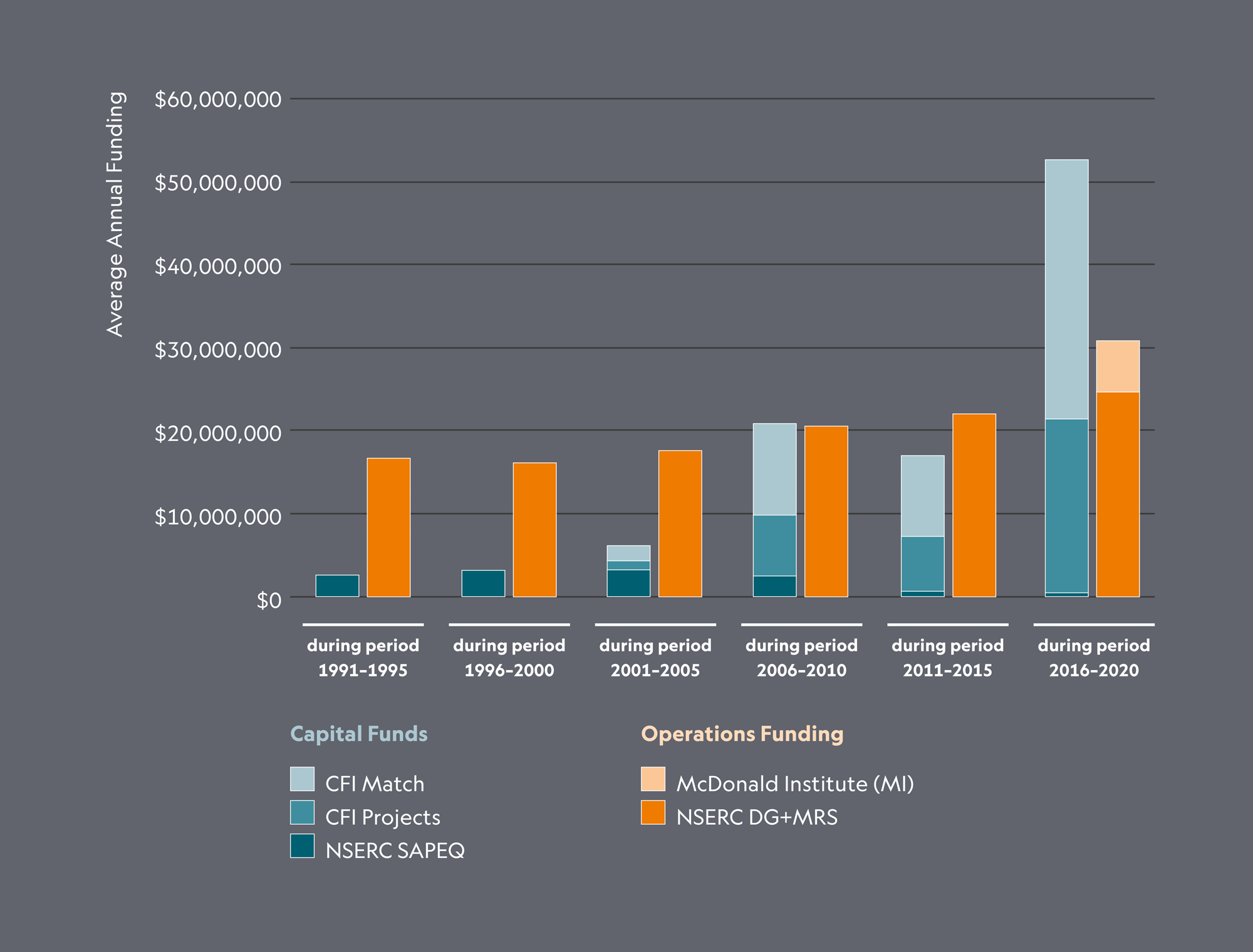
As noted above, the community has been particularly successful in securing capital support from CFI. However, growth in operations funding has been limited over the past decade. As illustrated in Figure 7, operations funding has not kept pace with capital investments in recent years, resulting in a significant change to the ratio of capital to operations funding.
In 2019/20, the NSERC SAP envelope of $26M amounted to 0.8% of all Tri-Council funding, and less than 2% of NSERC funding (https://www.nserc-crsng.gc.ca/NSERC-CRSNG/Reports-Rapports/plans-plans_eng.asp). This is well below the 3.8% of CFI funding awarded to SAP projects during this period, and points to limitations on the full exploitation of this capital investment to maximize scientific and training output. Indeed, the SAP envelope has been essentially flat between 2005 and 2015, which significantly eroded operational support after accounting for inflation. Since 2015, the envelope has increased by 23% ($5.5M), helping to alleviate what had become a critical deficit of operational project support. While this increase is welcome and will help to maximize the science impact of prior capital investments, after adjusting for 1.5% inflation, it amounts to approximately flat funding in real terms since 2005.
The success and evolution of the Canadian community, and the development of subatomic physics globally over the past 5 years, justifies further increases in the SAP envelope, as outlined below:
- Accommodating the transition of twelve CFREF-supported MI faculty into the SAP envelope (requiring $1.2M assuming current per FTE funding). These faculty are all embedded within the subatomic physics community and working on projects with timelines that extend beyond the CFREF program.
- Operational funding needs:
- Capitalizing on capital investment: The Subatomic physics community has continued to be highly successful in securing CFI funding for new experimental infrastructure at both onshore and offshore facilities. To capitalize on these investments, and allow the Canadian community to be internationally competitive, further operational funding is required.
- Maximizing training opportunities: recent investments in infrastructure at TRIUMF (in particular ARIEL) and SNOLAB (providing full usage of science user space) creates the opportunity to grow the global stature of these facilities, and build broad training opportunities for HQP. This requires sufficient operational support to maximize the science impact of the facilities. Investments in infrastructure at offshore facilities such as CERN and JLab also require full operational support to maximize training opportunities for Canadian HQP.
- Developing future flagship projects: as indicated in the portfolio, the next decade will see the first operation of several new international nuclear facilities (FRIB, FAIR, EIC), and a new generation of neutrino and dark matter detection experiments. The ability of the Canadian community to take on effective roles in these transformative projects will depend on both NSERC SAP envelope funding for operations and CFI and RTI funds for capital contributions. Full engagement in these projects will require further increases in the envelope into the second half of the decade.
- Full pursuit of the proposed research plan, including (a–c) above require a growth in research capacity and HQP over the next five years. Indeed, there is recognition that the community has the capacity to train 40% more graduate students. With the current number of investigators, and with average student stipends, this requires a $4M increase to the envelope, which would enable a number of the critical developments outlined above.
- New opportunities funding (e.g to support the RTI program) continues to be very limited, and restoring this fraction of envelope to a baseline of 5% requires additional funding ($1M)
In total, these arguments support growth of the SAP envelope by $6.2M (in current dollars) through 2026. This requested growth target would need to scale in proportion to further growth of the Canadian SAP investigator community.
Operational funding needs associated with 1, 2(a,b), and 3 reflect core components of the research program, and are critical to efficiently maximize the return on investment in ongoing projects, and the infrastructure developed at TRIUMF and SNOLAB and at offshore facilities. Further timely investment will allow for a more robust engagement with new international facilities, e.g. as outlined in 2(c), and other emerging opportunities.
The arguments outlined above, in combination with the science recommendations presented in Section 2, lead to the following recommendations for NSERC SAP envelope funding.
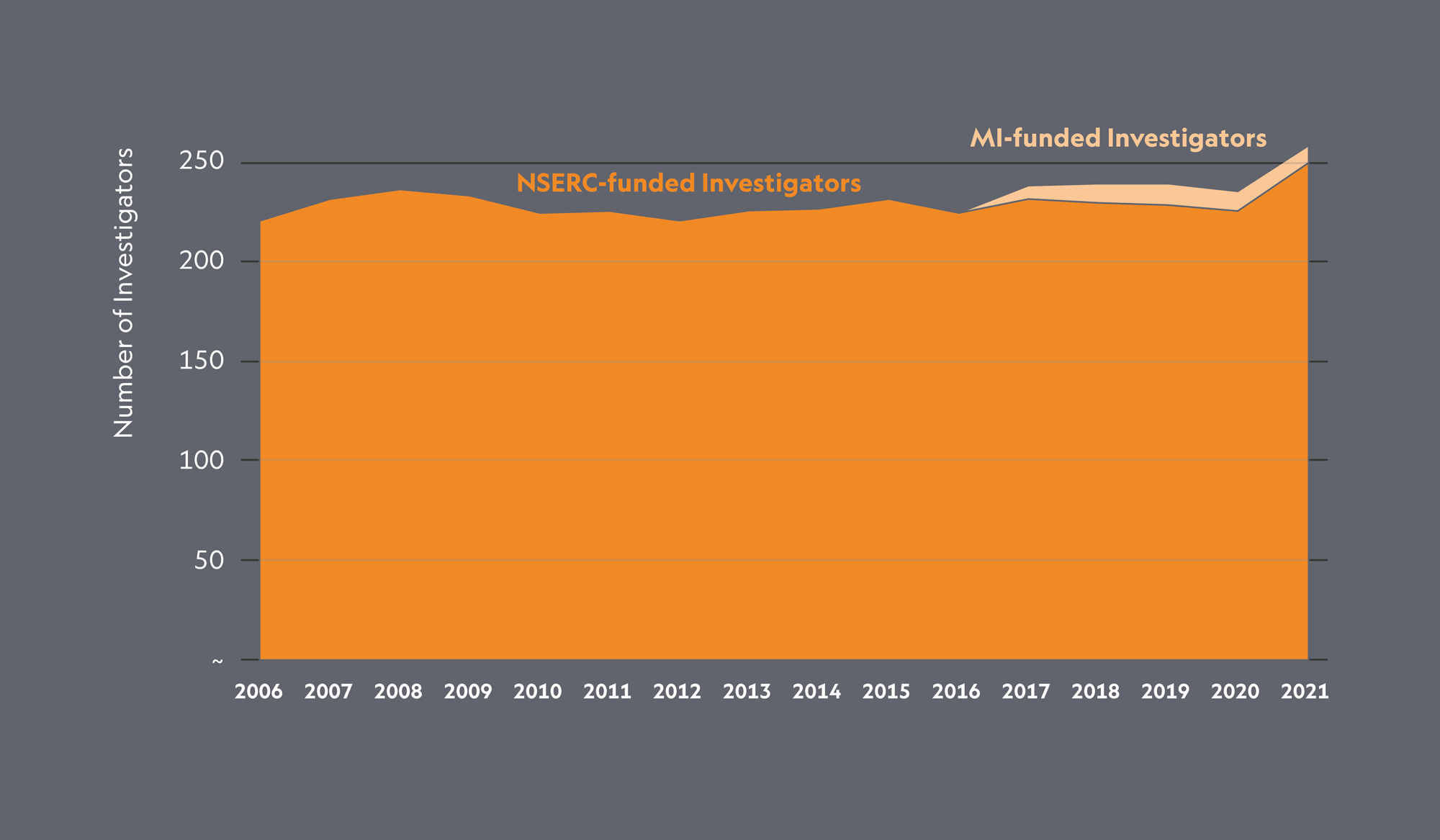
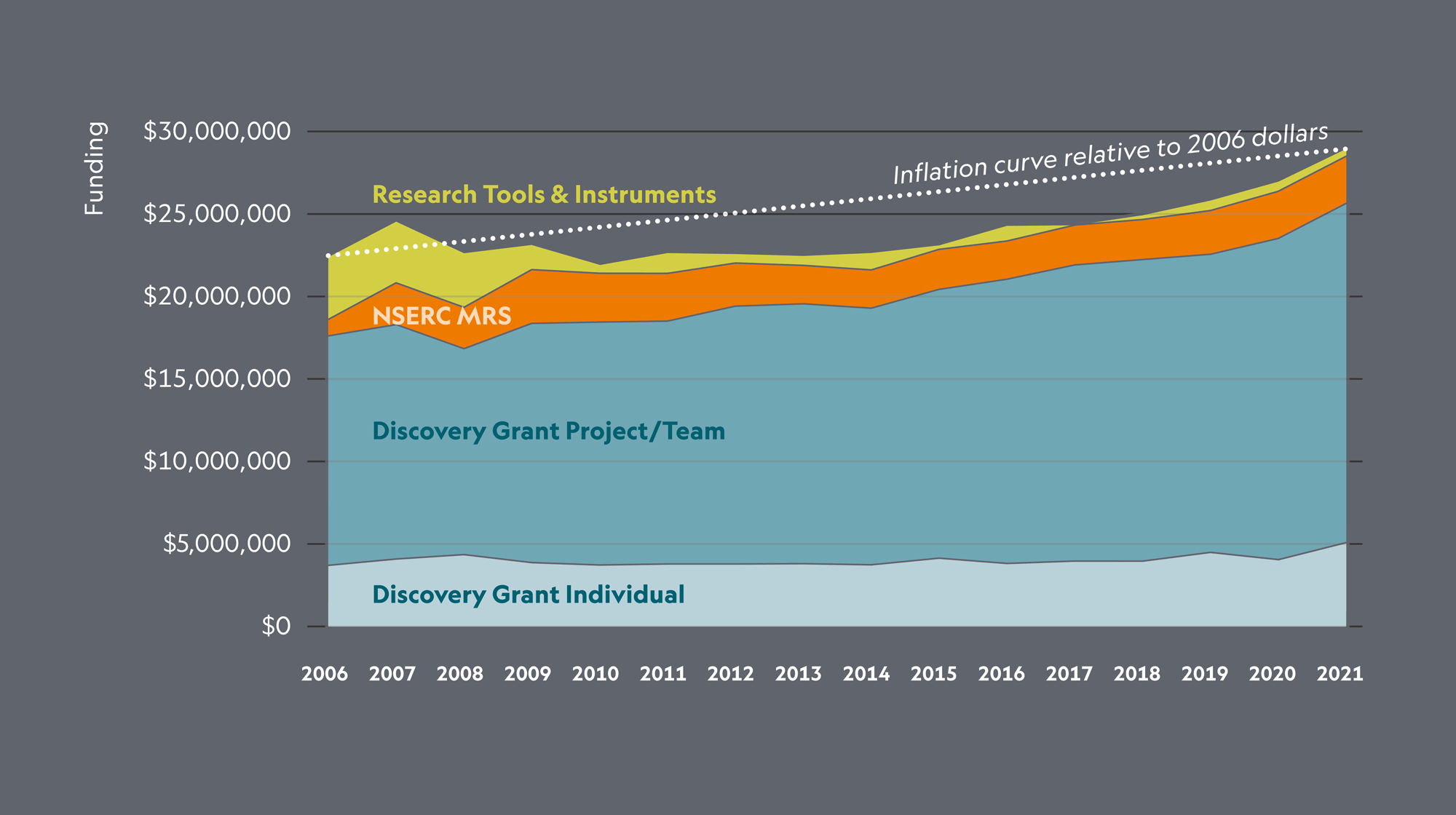
Funding Recommendation
9 —
NSERC Subatomic Physics Envelope
To maximize the impact of current and future investments, and to take advantage of future science opportunities, growth of the NSERC subatomic physics envelope is required for operational support.
- We recommend retention of the NSERC subatomic physics envelope structure, and its programs, which have been instrumental for the operational funding of subatomic physics research.
- We recommend growth of the NSERC subatomic physics envelope by $6.2M in 2021 dollars over the next five years to ensure that the Canadian program remains globally competitive. This growth is required for several reasons: to accommodate the transition of McDonald Institute faculty requiring NSERC support; to utilize the full community capacity for training of highly qualified personnel and maximize the return on capital investment; and to ensure sufficient availability of funds for small infrastructure projects and the development of future science opportunities.
- We recommend continued support for all the program categories available within the NSERC subatomic physics envelope; this includes the Major Resources Support (MRS) program, which critically supports the efficient collaborative use of unique technical resources in the development and construction of new instruments, and the Research Tools and Instruments (RTI) program which provides important support for detector and accelerator development.
- We recommend the monitoring and protection of the NSERC subatomic physics envelope fraction allocated to fund theory investigators. In addition, the minimum award threshold should not be below the level of funding required to support graduate training, as is the case in other Physics Evaluation Sections.
Infrastructure and Technical Support
In addition to capital and operations funding, support for key infrastructure is required to implement the research plan.
The major Canadian subatomic physics research laboratories and institutes provide critical value for the community, and are a core component of Canada’s infrastructure. The national laboratories, TRIUMF for nuclear and particle physics and accelerator-based science, and SNOLAB, for deep underground astroparticle science, along with the Perimeter Institute for Theoretical Physics, have global stature and play an important role in positioning Canada in the global subatomic physics community. These physical facilities are supported by virtual institutes, the Canadian Institute for Nuclear Physics (CINP) and the Institute of Particle Physics (IPP), with a membership that collectively encompasses the Canadian subatomic physics investigator community. Most recently, an injection of funds from the CFREF program facilitated the establishment of the McDonald Institute (MI), which supports the sub-community involved in underground astroparticle science.
Starting with the major experimental laboratories, TRIUMF and SNOLAB, recent investments (discussed in Section 3) will enable growth in their scientific output, and this will require sustained operational funding to fully exploit those prior investments. TRIUMF has recently transitioned from a joint venture to a not-for-profit corporation, and continues to rely on five-year federal funding allocations to support the majority of its operations and programs. SNOLAB continues to develop, and has been well supported through the CFI MSI program with provincial matching in Ontario. The flexibility in the MSI program is valuable. However, to fully develop as a global research laboratory, further flexibility to support research-focused technical staff would be valuable.
Funding Recommendation
10 —
Support for Canada’s World-leading Centres
Canada’s large-scale centres for subatomic physics research have global stature, and provide competitive advantages in pursuing high-priority scientific programs.
We recommend maintaining strong support for Canadian centres (TRIUMF, SNOLAB, Perimeter Institute) so that they remain at the forefront of research worldwide.
The efficient sharing of resources within the subatomic physics community has been important for its success. In part, this includes the community-led research supports such as MRS technical support labs across the country, and the IPP Research Scientist program. The latter program, which funds eight senior experimental research scientists who are able to lead Canada’s participation in major international projects, has been critical in enabling Canada to take on leadership roles in these projects. This value is highlighted clearly in the IPP Brief to the LRP, which emphasizes that the Canadian particle physics community considers the IPP Research Scientist program to be its highest funding priority.
Funding Recommendation
11 —
IPP Research Scientist Program
The IPP Research Scientist program has had a major impact on Canada’s leadership and contributions to international projects.
We recommend maintaining full support for the IPP Research Scientist program.
The McDonald Institute, currently supported by the CFREF program, has been a significant addition to the Canadian subatomic physics community since the last LRP. It has supported the growth of the sub-community focused on underground and sub-surface observatories seeking to study neutrinos and dark matter. In particular, this funding has enabled the development of significant technical support programs at partner institutions, and it would be valuable to maintain this support once the CFREF funding comes to an end.
Funding Recommendation
12 —
Arthur B McDonald Institute
The existence of the Arthur B McDonald Institute and its research support and outreach programs has added considerable value to the community. However, its CFREF funding is coming to an end.
We recommend that in addition to growth of the NSERC subatomic physics envelope to support operational costs, new mechanisms be identified to fund and maintain continuity of the research and technical support programs provided by the Institute.
Subatomic physics has for many years been one of the leaders in the development of research computing and networking, with the world wide web famously developed at CERN, and machine learning tools used for many years in simulation and data analysis. The ongoing and future computing needs are hard to overstate, with increasing data rates and the need for high precision modelling and simulation. The subatomic physics community has been a major user of Compute Canada services, and relies on CANARIE for networking infrastructure, along with dedicated support services such as the MRS-funded HEPNET program. With Canadian research computing infrastructure undergoing a period of restructuring, members of the community have been fully engaged in the development of the new Digital Research Alliance (formerly NDRIO). It is important that these new structures that emerge have the appropriate organization and sufficient resources to address the specific needs of the subatomic physics community over the coming decade.
Funding Recommendation
13 —
Canada’s Digital Research Infrastructure
All components of digital research infrastructure (e.g. Compute Canada, CANARIE) are critical to the success of subatomic physics research.
We recommend that CANARIE continues to be funded by the Canadian federal government for operation of the national research network and key links to our international partners. Further, we recommend that critical computing infrastructure provided by national computing organizations (Compute Canada and the Digital Research Alliance (formerly NDRIO)) continue to be strongly supported by federal and provincial governments, at a level appropriate to address the needs of the subatomic physics research community.
The longer-term 15-year outlook for this LRP brings into focus the importance of enabling research and development that will facilitate Canada’s participation in new domestic and international project opportunities that may emerge in coming years. The development and application of emerging technologies is critical to assess their utility in enabling progress in subatomic physics. Efforts that are not directly tied to a specific project are valuable, but difficult to fund within the current ecosystem.
Funding Recommendation
14 —
Funding for R&D Activities
New research opportunities are enabled by the development of novel instruments and technologies. This development relies upon the ability to explore technological frontiers that are beyond the scope of individual subatomic physics experiments.
We recommend that appropriate mechanisms be identified to efficiently fund modest and timely investments in generic R&D activities that have the potential to address the scientific goals of subatomic physics research.
Research Policy
Canada’s subatomic physics research program makes use of major onshore facilities such as SNOLAB and TRIUMF, but also utilizes the best facilities worldwide to conduct research. These facilities include CERN in Switzerland, which hosts the LHC; JPARC and KEK in Japan, which host the T2K and Belle II experiments, respectively; JLab in the US, which is one of the major nuclear user facilities globally; and a number of other labs worldwide.
The participation of the community in large-scale global projects is an intrinsic feature of subatomic physics research, and in this era of growing security concerns it is important that this openly collaborative aspect be maintained. However, the need for large-scale collaboration also highlights some structural concerns with the Canadian research ecosystem. In particular, while NSERC and CFI provide valuable support for the development of projects and project components up to a threshold of $10–20M, there is less structure in place to facilitate Canada’s involvement in larger-scale projects, or the associated in-kind contributions that may be needed for participation in international laboratories. Within Canada, examples of potential large-scale initiatives over the coming decade include an expansion of the science cavern space at SNOLAB, and the development of a storage ring at TRIUMF. It is also highly valuable for those labs to continue enabling the participation of Canadians at international offshore labs, for example by providing in-kind contributions such as those for the LHC accelerator complex that supports Canada’s participation at CERN and involvement in the ATLAS experiment. This role is enhanced by the continuing development of world-leading infrastructure and expertise at these labs. However, it is notable that support by the labs for offshore engagements has often required an ad hoc negotiation process.
The above concerns highlight the fact that establishing a national structure to oversee the full life-cycle development and management of large-scale projects with total costs of over $50M, and a single point of contact to help develop and manage international agreements, would greatly assist the community in engaging fully in emerging large-scale science opportunities over the coming decade.
Policy Recommendation
15 —
Support for Large-scale Science Endeavours
Coordination of the capital costs and operational funding over the life-cycle of large-scale (≳ $50M) science endeavours and infrastructure projects is difficult within the current ecosystem.
We recommend the formation of a new administrative structure to provide this coordination (as articulated in Recommendation 4.7 of Canada’s Fundamental Science Review 2017: Investing in Canada’s Future, http://sciencereview.ca).
Policy Recommendation
16 —
Canadian Office for International Research Engagement
Subatomic physics research is intrinsically global, and increasingly requires complex multinational agreements.
We recommend the identification of an office in Canadian government responsible for engaging with the international community with the goal of advancing major new science initiatives.
Studying subatomics physics presented many challenges that helped me learn mechanical, coding, research, analysis and problem solving skills. But perhaps most importantly it showed me that I am a capable learner. This gives me confidence in my competence as I move forward in another career path. More practically, I was able to engage in science communication projects throughout my Master’s degree that gave me experience which directly relates to my current position. Being supported in my science communication projects gave me soft skills that complemented the harder skills I got in physics.
— Lia Formenti (MSc McGill 2021), Online Events Coordinator, Let’s Talk Science
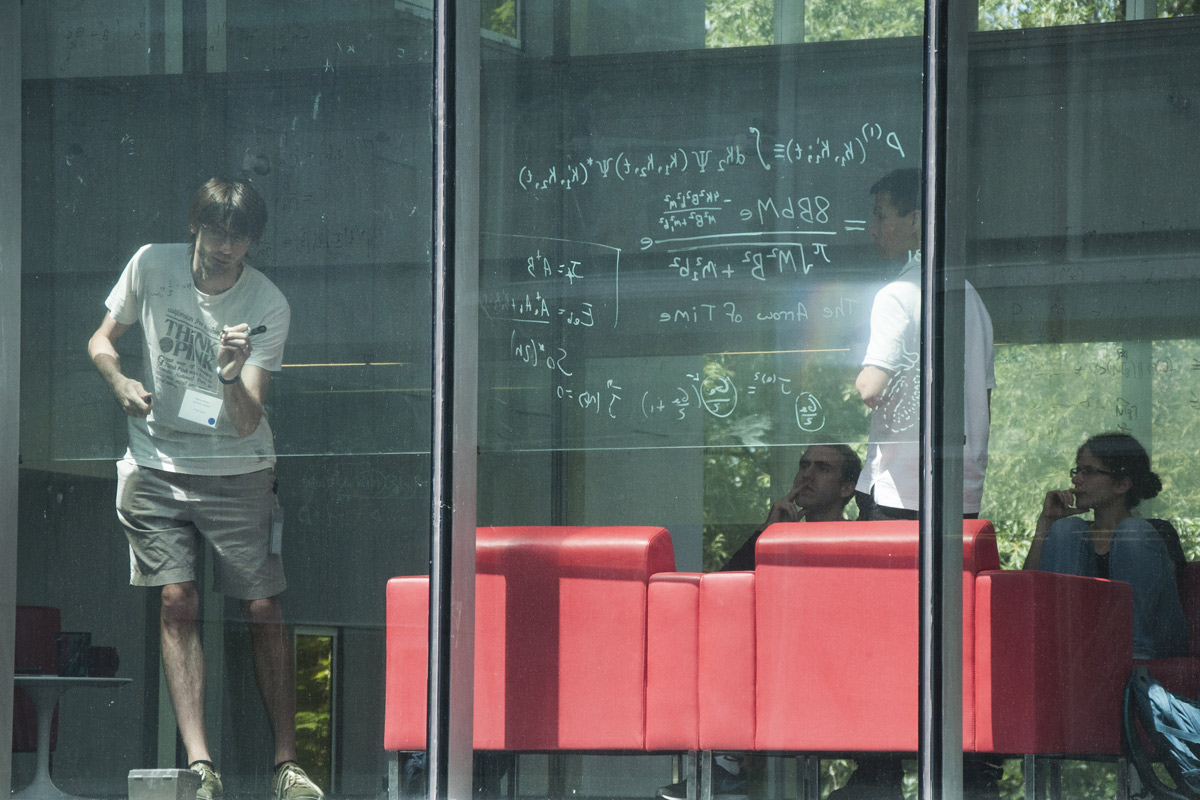
Researchers interacting at the Perimeter Institute for Theoretical Physics. [Credit: Perimeter Institute]
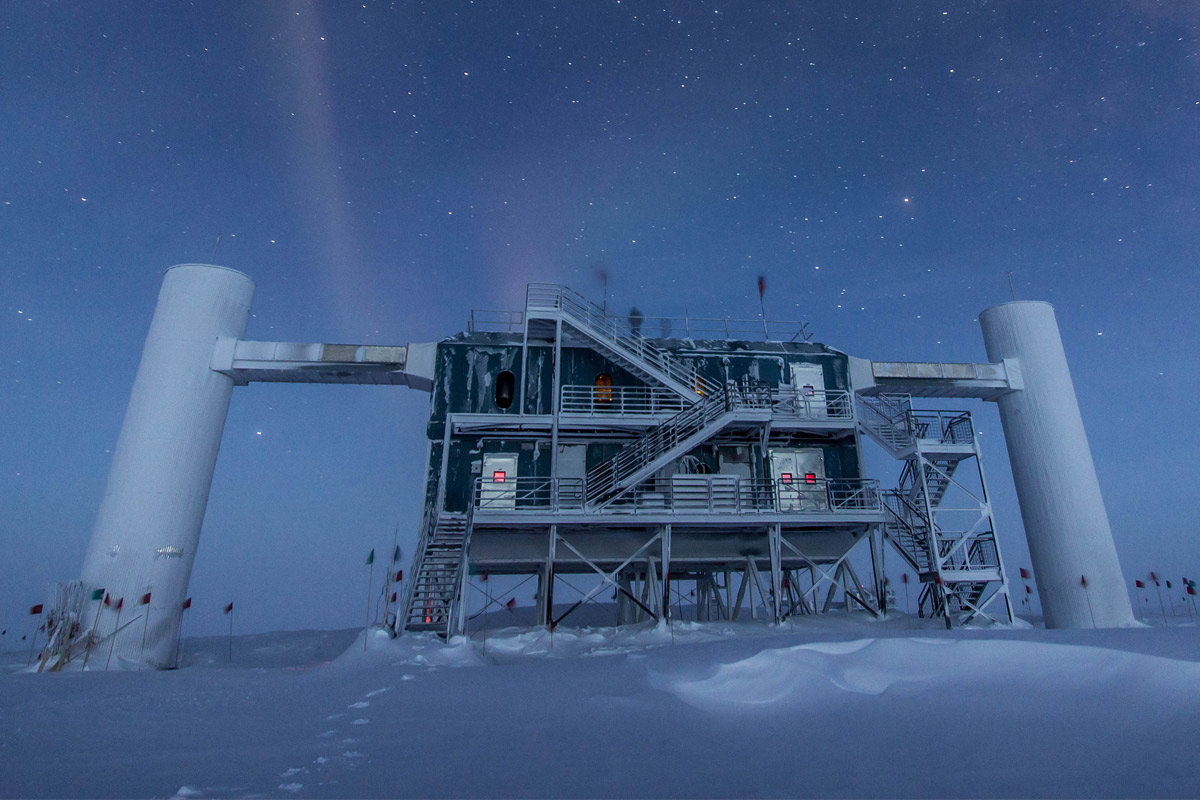
The IceCube Laboratory at the Amundsen-Scott South Pole Station in Antarctica. [Credit: F. Pedreros, IceCube/NSF.]
